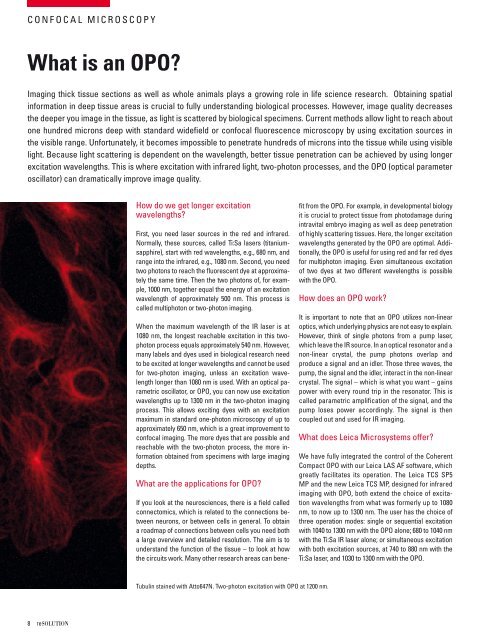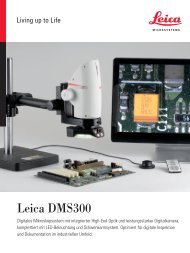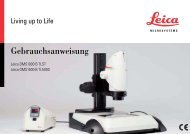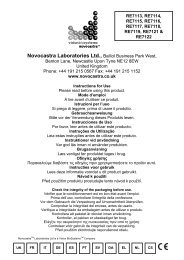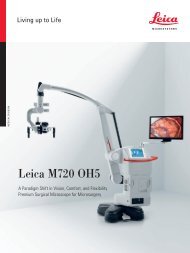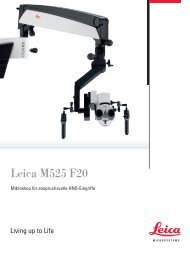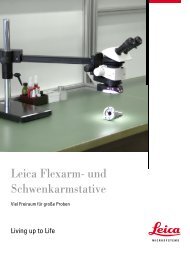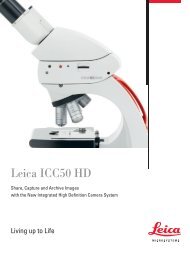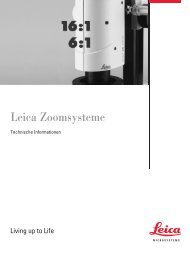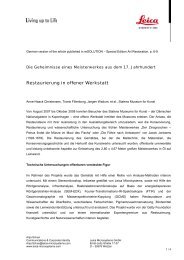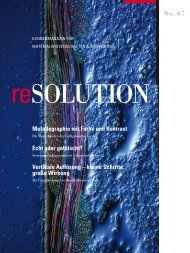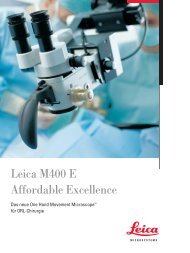reSOLUTION_Research_09_Neuroscience - Leica Microsystems
reSOLUTION_Research_09_Neuroscience - Leica Microsystems
reSOLUTION_Research_09_Neuroscience - Leica Microsystems
Create successful ePaper yourself
Turn your PDF publications into a flip-book with our unique Google optimized e-Paper software.
confocal microscoPy<br />
What is an OPO?<br />
imaging thick tissue sections as well as whole animals plays a growing role in life science research. obtaining spatial<br />
information in deep tissue areas is crucial to fully understanding biological processes. However, image quality decreases<br />
the deeper you image in the tissue, as light is scattered by biological specimens. current methods allow light to reach about<br />
one hundred microns deep with standard widefield or confocal fluorescence microscopy by using excitation sources in<br />
the visible range. unfortunately, it becomes impossible to penetrate hundreds of microns into the tissue while using visible<br />
light. because light scattering is dependent on the wavelength, better tissue penetration can be achieved by using longer<br />
excitation wavelengths. this is where excitation with infrared light, two-photon processes, and the oPo (optical parameter<br />
oscillator) can dramatically improve image quality.<br />
8 resolutioN<br />
How do we get longer excitation<br />
wavelengths?<br />
first, you need laser sources in the red and infrared.<br />
normally, these sources, called ti:sa lasers (titaniumsapphire),<br />
start with red wavelengths, e.g., 680 nm, and<br />
range into the infrared, e.g., 1080 nm. second, you need<br />
two photons to reach the fluorescent dye at approximately<br />
the same time. then the two photons of, for example,<br />
1000 nm, together equal the energy of an excitation<br />
wavelength of approximately 500 nm. this process is<br />
called multiphoton or two-photon imaging.<br />
When the maximum wavelength of the ir laser is at<br />
1080 nm, the longest reachable excitation in this twophoton<br />
process equals approximately 540 nm. However,<br />
many labels and dyes used in biological research need<br />
to be excited at longer wavelengths and cannot be used<br />
for two-photon imaging, unless an excitation wavelength<br />
longer than 1080 nm is used. With an optical parametric<br />
oscillator, or oPo, you can now use excitation<br />
wavelengths up to 1300 nm in the two-photon imaging<br />
process. this allows exciting dyes with an excitation<br />
maximum in standard one-photon microscopy of up to<br />
approximately 650 nm, which is a great improvement to<br />
confocal imaging. the more dyes that are possible and<br />
reachable with the two-photon process, the more information<br />
obtained from specimens with large imaging<br />
depths.<br />
What are the applications for oPo?<br />
if you look at the neurosciences, there is a field called<br />
connectomics, which is related to the connections between<br />
neurons, or between cells in general. to obtain<br />
a roadmap of connections between cells you need both<br />
a large overview and detailed resolution. the aim is to<br />
understand the function of the tissue – to look at how<br />
the circuits work. many other research areas can bene-<br />
tubulin stained with atto647n. two-photon excitation with oPo at 1200 nm.<br />
fit from the oPo. for example, in developmental biology<br />
it is crucial to protect tissue from photodamage during<br />
intravital embryo imaging as well as deep penetration<br />
of highly scattering tissues. Here, the longer excitation<br />
wavelengths generated by the oPo are optimal. additionally,<br />
the oPo is useful for using red and far red dyes<br />
for multiphoton imaging. even simultaneous excitation<br />
of two dyes at two different wavelengths is possible<br />
with the oPo.<br />
How does an oPo work?<br />
it is important to note that an oPo utilizes non-linear<br />
optics, which underlying physics are not easy to explain.<br />
However, think of single photons from a pump laser,<br />
which leave the ir source. in an optical resonator and a<br />
non-linear crystal, the pump photons overlap and<br />
produce a signal and an idler. those three waves, the<br />
pump, the signal and the idler, interact in the non-linear<br />
crystal. the signal – which is what you want – gains<br />
power with every round trip in the resonator. this is<br />
called parametric amplification of the signal, and the<br />
pump loses power accordingly. the signal is then<br />
coupled out and used for ir imaging.<br />
What does leica microsystems offer?<br />
We have fully integrated the control of the coherent<br />
compact oPo with our leica las af software, which<br />
greatly facilitates its operation. the leica tcs sP5<br />
mP and the new leica tcs mP, designed for infrared<br />
imaging with oPo, both extend the choice of excitation<br />
wavelengths from what was formerly up to 1080<br />
nm, to now up to 1300 nm. the user has the choice of<br />
three operation modes: single or sequential excitation<br />
with 1040 to 1300 nm with the oPo alone; 680 to 1040 nm<br />
with the ti:sa ir laser alone; or simultaneous excitation<br />
with both excitation sources, at 740 to 880 nm with the<br />
ti:sa laser, and 1030 to 1300 nm with the oPo.


